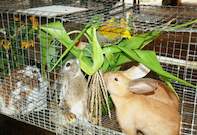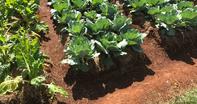Whatever style of feeding your rabbits you decide to follow, it is important that it is consistent. Feed at the same time every day, but it is better to feed twice per day than once.

Make sure that all feed is fresh and completely free of mould. Where there is more than one rabbit in a cage make sure that all of them can feed comfortably at the same time.
Feed troughs should be narrow enough to ensure that no rabbit can sit in them easily and must be kept spotlessly clean at all times. Never change feed suddenly. In the wild rabbits eats what is available as per the season. Seasons change slowly and any change in feed should be introduced slowly.
Water
Water must be available at all times and should be fresh. If any system is used other than nipples, these containers should be algae-free and cleaned regularly.Hay
Hay is an essential part of the rabbit's diet and must be available at all times. Hay can be made from a variety of dried grasses such as teff, eragrostis, red orchard grass, oats and most fine grasses. A mixture of grasses can be planted together to give a tasty and varied hay.
Herbs like parsley and stinging nettles can also be added to the mix. Oat hay makes a very good feed but should not be given to does about to kindle (give birth). If oat hay is put in their nest box, the tiny barbs on the oat seed can puncture the babies' tummies and can kill them.
Thick thatch grass has very few nutrients and is not palatable and therefore is not classified as hay. Hay must be stored in a dry and cool place. Mouldy hay is very dangerous and every care must be taken to keep the hay fresh.
Lucerne
Lucerne is an excellent source of protein and should be used as a protein feed and not used as a hay. It is too high in protein and an excess will cause bloat. There are several ways lucerne can be fed. Lucerne can be fed fresh and must be introduced slowly and immediately after cutting as it is very palatable and refreshing.
Wilted lucerne will cause serious bloat and can kill the rabbit. However, an hour after feeding all left-overs must be removed from the cages and put onto the compost heap. Lucerne can also be fed dried. Because the bulk of the food value of the dried lucerne is in the leaf, it is a good idea to place the lucerne hay either on a sheet of cardboard or in a container.
A hay rick with a solid bottom can be used. The dry leaves fall off the stalk very easily and this is a total waste of an expensive feed resource.
The best way to feed dried lucerne is as a chop in a feed dish that is emptied and cleaned regularly. Lucerne pellets are available from all feed suppliers and can replace all other concentrated feed provided it is backed up with good hay and fresh, clean green feed.

Concentrates
Concentrated high protein rabbit pellets are available from all feed suppliers, however, they are expensive. Pellets are not essential to successful small-scale production that aims at food security rather than mass production for the export or luxury markets. Ideally, a small ration of pellets or lucerne pellets backed by hay and green feed will ensure reasonable growth of healthy youngsters.
The quantity of feed required depends on the quality of the hay and green feed but 80 gm (about a tuna tin) per rabbit per day can be used as a starter point.
Green Feed
Without an active vegetable and herb garden, this form of sustainable rabbit farming will fail. Communities and farmers that want to keep rabbits as a meat source to feed their families must have a thriving vegetable garden that produces an excess of the community requirement right through the year.
There can be no time during the year when the garden cannot supply the needs of the people or animals that depend on it to survive. Some vegetables are poisonous and should not be fed to rabbits. These include potato plants, tomato plants and rhubarb. Pumpkin, squash and melon plants are also not good for rabbits.
The best vegetables for rabbits are carrots, spinach, kale, marog (also known as wild spinach), cauliflower leaves and excess cauliflower heads, broccoli and beetroot. If you are not sure of a new vegetable, offer a small portion to the rabbit with other feed that you know it likes. The rabbit will ignore an unsuitable plant unless it is very hungry (which should never happen).
Herbs are equally important as vegetables. Not only are herbs considered as food, they are also natural medicines. See the Health section on which herbs are best for rabbits.
By Karoline Steenekamp